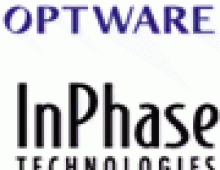
Terabyte Optical Disc in development
Earlier this week, Japanese company Optware told IDG News that it will commercialize an optical disc that can store more than 1 terabyte of data, as well as an associated disc player. Both systems are due on the market later this year. The disc and player are based on a 5-inch optical disc like existing CDs and DVDs. The new disc will be able to store about 120 DVD-format movies, Atsushi Machida, a spokesman for Optware told IDG News.
IDG News cites a statement from Optware that states that the high capacity, around 20 times the storage available on existing discs, and a data transfer speed of 1 gigabit per second has been achieved by using digital volume holography read/write technology. The technology was developed under the Defense Advanced Research Project Agency (DARPA) in the United States.
The system works by first splitting a laser source into two beams: signal (data-carrying) and reference beams. The signal beam goes through a spatial light modulator. This modulator has pages of data arranged in a checkerboard pattern. The pattern either blocks or transmits light; therefore the signal beam will encode data via the spatial light modulator.
This encoded beam then interferes with the reference beam via an optical lens to record onto a photosensitive volumetric recording medium. By changing the angle or wavelength of the reference beam, the technology allows many different data pages to be recorded in three dimensions and read out in the same recording medium, thus allowing for enormous storage capacity.
The technology, in this form is costly, unreliable, and not compatible with existing disc media. "That was the reason why it has been said that an optical disc based on holography is difficult for commercialization," Machida continued.
Optware told IDG News that they have developed a reliable method of storing data in 3D on existing CD/DVD media. While conventional optical disc systems use a single red laser beam to write a dot, containing 1 bit of information, to a disc's surface, Optware's technology, dubbed "polarized collinear holography", splits the signal laser beam into 1 million narrower beams.
The systems creates data pages in the same way as the DARPA system, and with the help of a separate reference laser beam, writes the data in 3D to the disc's volumetric recording layer. One million bits of information can be stored for each dot, Optware boasted. The company will start sample shipping of the disc and the replay device in the third quarter of this year. Its first product will be a write-once disc, to be followed by rewritable discs, Machida continued.
The system works by first splitting a laser source into two beams: signal (data-carrying) and reference beams. The signal beam goes through a spatial light modulator. This modulator has pages of data arranged in a checkerboard pattern. The pattern either blocks or transmits light; therefore the signal beam will encode data via the spatial light modulator.
This encoded beam then interferes with the reference beam via an optical lens to record onto a photosensitive volumetric recording medium. By changing the angle or wavelength of the reference beam, the technology allows many different data pages to be recorded in three dimensions and read out in the same recording medium, thus allowing for enormous storage capacity.
The technology, in this form is costly, unreliable, and not compatible with existing disc media. "That was the reason why it has been said that an optical disc based on holography is difficult for commercialization," Machida continued.
Optware told IDG News that they have developed a reliable method of storing data in 3D on existing CD/DVD media. While conventional optical disc systems use a single red laser beam to write a dot, containing 1 bit of information, to a disc's surface, Optware's technology, dubbed "polarized collinear holography", splits the signal laser beam into 1 million narrower beams.
The systems creates data pages in the same way as the DARPA system, and with the help of a separate reference laser beam, writes the data in 3D to the disc's volumetric recording layer. One million bits of information can be stored for each dot, Optware boasted. The company will start sample shipping of the disc and the replay device in the third quarter of this year. Its first product will be a write-once disc, to be followed by rewritable discs, Machida continued.




















